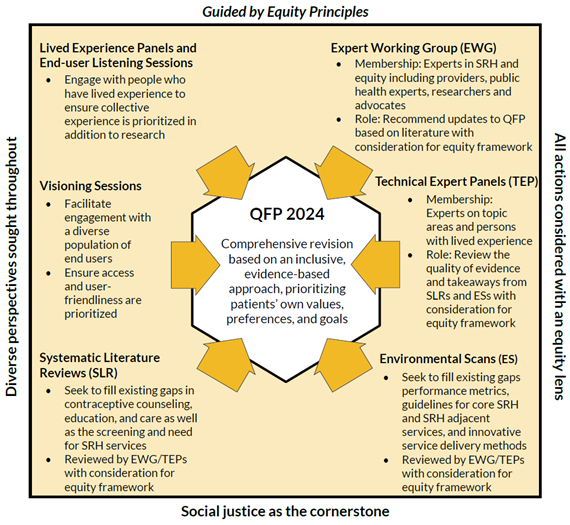
Overview of the Quality Family Planning Recommendations
- Providing Quality Family Planning Services in the United States: Recommendations of the U.S. Office of Population Affairs (Revised 2024)
- Providing QFP Services in the U.S. 2024 (interactive web-based version)
Learn about the QFP Recommendations
These recommendations are an update to Providing Quality Family Planning (QFP) Services: Recommendations of the Centers for Disease Control and Prevention (CDC) and the U.S. Office of Population Affairs (OPA), initially published in 2014. The QFP recommendations establish clinical best practices, guidelines, and recommendations for sexual and reproductive health (SRH) care and services.
The updated QFP recommendations outline how to provide people of reproductive age with high-quality SRH services, including:
- Family-building services,
- Contraceptive services,
- Pregnancy testing and counseling,
- Early pregnancy management,
- Sexually transmitted infection (STI) and human immunodeficiency virus (HIV) prevention and testing services, and
- Other screening and preventive health services.
The goal of these recommendations is to set the gold standard for the provision of evidence-based SRH care that is inclusive, equitable, and person-centered and focused on individuals’ needs, values, and preferences. The update offers specific recommendations for how to provide high-quality SRH care and connects providers to relevant guidelines, primary research, and other resources to inform best practices.
What is QFP and why do we need it?
QFP continues to be the only set of national clinical recommendations on contraceptive care delivery. Several changes have affected SRH care delivery in the U.S. during the past decade, underscoring the critical need for comprehensive guidance for providers. Those changes include:
- Technological advances put forward new contraceptive methods, modifications to existing contraceptive methods, new ways of preventing STIs, and more widely adopted service delivery options. Existing technologies like telehealth have also expanded and become more user friendly.
- Recognition of long-standing inequities, within and beyond the health care realm, has influenced what we consider high-quality SRH care. Systemic inequalities have long impeded people’s ability to receive high-quality SRH care, including contraceptive care.
- Legal and regulatory changes at the federal, state, and local levels have affected access to SRH care through various mechanisms, including funding, insurance coverage, legal restrictions, public programs, and provider availability. Some of these changes have limited access while others have enhanced access.
Who uses QFP recommendations?
The primary audience for this update is clinical providers and potential providers of SRH services to people of reproductive age. These recommendations are for providers working in service sites dedicated to SRH service delivery, including:
- Title X-funded clinics,
- Federally qualified health clinics (FQHCs),
- Primary care providers,
- Specialists, and
- Other providers who may identify SRH needs and make referrals.
Medical directors and others responsible for developing clinical protocols may also use the QFP recommendations to support policy and protocol development.
 An official website of the United States government
An official website of the United States government

